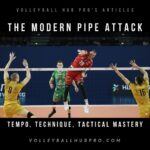Introduction
A successful volleyball preseason lays the foundation for a competitive and accomplished season. Coaches must strategically design and implement training to optimize team development in a limited timeframe. This planning requires expertise across technical skills, physical conditioning, program periodization, and athlete motivation. Several key considerations emerge for structuring an effective preseason.
Technical work and physical conditioning in the first week of training: focus on passing, serving, attacking and defense, with gradual introduction of jumping exercises
The first week of preseason training is crucial for laying the technical and physical foundation for the upcoming season. Coaches should focus on fundamental skills like passing, setting, serving, attacking and defense. Players will be rusty after the off-season break, so a progressive approach is needed to rebuild skills and avoid overuse injuries.
Passing drills should emphasize proper platform shape, footwork, and ball control. Targeted serving practice establishes rhythm and aim. Blocking footwork and arm swing are introduced without full jumping to activate muscles. For attacking, coaches incorporate tossing or passing before hitting to redevelop timing. Defensive movements are integrated at moderate intensity after proper warmups.
A key component is progressively integrating jumping and impact. Early jumping may be done on sand or with limited approach steps. By midweek, players can perform basic jumps and arm swings. Hard attacking and jump serves are introduced later, followed by rest days. This gradual buildup reactivates muscles while allowing recovery to maximize training. Proper progressions optimize technical proficiency and reduce injury risk as players resume full training loads.
Training programming in the first 2-3 weeks: progressive development of gameplay, introduction of sideout and transition, individual work on fundamentals
The first 2-3 weeks of preseason training are focused on systematically developing key aspects of team gameplay. Coaches progress from isolated skill work to full 6 vs 6 systems.
Serving and serve-receive are trained first to build the foundation of sideout. Players develop passing rhythm, targeting, and communication. Serving aims for consistency with controlled speed. Transition opportunities are generated through downballs or overpasses.
Blocking and defense come next. Block timing and positioning are worked individually before full schemes. Quality arm swing repetition develops defense. Scrimmage-like drills pressure players to read, react, and move seamlessly between offense and defense.
Throughout this period, coaches allot individual training time. Athletes reinforce fundamentals like arm swing, footwork patterns, and specific problem areas. Goals and improvement metrics are set for each player. Individual feedback ensures skillsstay sharp before systems integration.
By week 2-3, all components come together in 6 vs 6 games. Rotations, match tempo, and point scoring add realism. Coaches can identify lineup combinations that connect skills into an effective team attack and defense. Gradual introduction of full gameplay optimizes learning and results.
Optimal preseason preparation: approximately 8 weeks, with gradual increase in training loads
Most coaches recommend around 8 weeks of preseason training to properly prepare teams for peak performance. This duration allows for safe, progressive building of fitness and skills without overloading athletes.
The first 2-3 weeks focus on rebuilding technical and physical capacities after time off. Strength training, conditioning, fundamentals, and low-intensity gameplay are emphasized.
Weeks 4-6 integrate abilities into systems and tactics. Higher intensity training sharpens reactions and timing. Scrimmages against other teams provide valuable experience.
The final 2-3 weeks taper training volume to maximize freshness. Challenging workout components continue to fine-tune speed and execution. Full rest days recoup energy stores. The priority is optimizing fitness and performance for upcoming first matches.
An 8-week preseason enables athletes to gradually adapt to increasing demands. Careful periodization allows cumulative stress to drive positive training effects without risking injury, fatigue, or burnout. With an organized plan, teams can peak physically and mentally for the transition from practice to competitions.
Management of the coaching staff: initial briefing with strength coach and assistants, constant communication
Effective management of a coaching staff is crucial for achieving alignment and teamwork in pursuit of performance goals. This starts before the players even arrive for preseason.
The head coach should clearly communicate training priorities and plans to assistants and strength coaches. An initial briefing allows staff to understand their roles and responsibilities in implementing the coach’s vision.
Frequent check-ins during training ensure proper sequencing of technical, tactical, and physical development. Differences in athlete responses are discussed to determine optimal individual prescriptions. Feedback from staff who directly observe players is valued to adjust training as needed.
Open communication channels help prevent contradictory instructions that cause confusion. Staff cooperation maximizes development results. Issues are addressed collaboratively to find the best solutions.
Players notice staff cohesion, which enhances belief in the process. A united coaching team sets the tone for an effective training environment. Athletes can fully trust the guidance when staff demonstrate mutual support and respect.
Player motivation and engagement: accountability, clear objectives, continual feedback
Maximizing player motivation and active engagement in training is crucial for a productive preseason. Coaches can promote buy-in through accountability, clear objectives, and continual feedback.
Players must be held responsible for putting in focused effort. Coaches should explain that commitment leads to mastery and achievement. Athletes must be punctual and bring positive energy to drive team progress.
Written training plans with specific technical and fitness markers provide roadmaps to improvement. Players understand the objectives behind each drill. Explaining the “why” gives activities purpose and meaning.
Daily individual and team feedback highlights successes versus problem areas. Recognition of progress is encouraging. Constructive criticism provides details for correcting errors. Players appreciate understanding exactly how to refine skills.
When athletes are invested in team goals, they actively participate. Motivation comes from within when players feel empowered in their development journey. Coaches can facilitate internal drive through thoughtful communication and planning.
Individual player analysis: fitness testing, technical evaluation, goal-setting
Preseason allows time for coaches to objectively analyze each athlete’s abilities and create customized improvement plans. Testing, evaluation, and goal-setting are key components of this process.
Coaches assess physical qualities through tests of speed, power, agility, endurance, and movement. Strength coaches measure maximum lifts and body composition. Comparing scores over time charts progress.
Technical skills are observed in drills and scrimmages. Coaches identify strong points and deficiencies for every player. Highlighting gaps informs training priorities to elevate overall team execution.
Measurable markers for fitness benchmarks and skill proficiency are established based on testing data and season objectives. Athletes have clear performance targets to strive towards independently and in group training.
Continual re-evaluation determines progress on tangible development metrics. Adjustments are made to challenge players appropriately as capacities expand. Optimizing each individual lifts collective team capabilities.
Detailed player analysis enables personalized improvement plans. Players feel invested in their growth when coaches devote focused attention. A data-driven approach maximizes training effectiveness.
Use of technology: video recording of practices for analysis and improvement
Recording practices with video cameras and reviewing the footage offers invaluable opportunities for individual and team improvement during preseason training. This readily accessible technology should be embraced by coaches and athletes alike.
Capturing various technical drills and full scrimmage videos preserves memories coaches cannot fully absorb in real time. Re-watching with a more objective eye reveals extra details about positioning, mechanics, decision-making and other subtleties.
Sharing clips with players immediately highlights examples of proper technique and common errors to correct. Quick visual feedback accelerates skill refinement. Coaches point out specifics and activate self-assessment.
Video enables remote collaboration for coaches who cannot attend all sessions. Editing creates compilation reels isolating strengths and weaknesses. Data like time between rallies or hitting percentages help inform training plans.
Athletes learn the tactical dimensions of the game by seeing court movements and tendencies. Reviewing match footage engrains successful plays to repeat. Videos inspire players to reach new levels through self-critique.
Video analysis is a difference-making component of preseason progress when used consistently. It augments live training with an unbiased visual record for growth. This technology is a must-have coaching tool.
Conclusion
In summary, a thoughtful preseason training plan is crucial for building a cohesive volleyball team primed for in-season performance. Coaches must focus on safely progressing technical and tactical skills through drill progressions and system integration. A gradual ramp up of physical conditioning reactivates the body while preventing injury. Player buy-in is fostered through clear objectives, continual feedback, and individualized improvement plans. Staff unity provides consistent messaging and development. Technology like video analysis enhances learning. Adhering to proven training principles will equip the team for competitive success.









Leave a Reply
You must be logged in to post a comment.